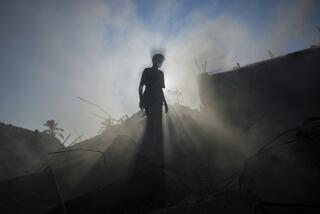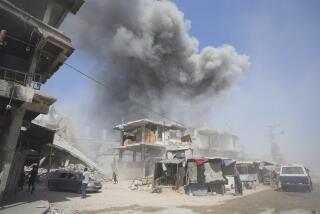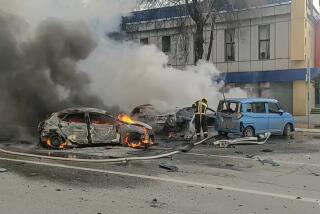Shelling Kills 11 at Sarajevo Soccer Game : Bosnia: U.N. ‘havens’ are proving less than safe. Disease in Srebrenica drives many to risky escape attempts.
- Share via
SARAJEVO, Bosnia-Herzegovina — Heavy shelling from Serbian positions killed at least 11 people and wounded dozens at a soccer match Tuesday in a suburb of this capital city that the United States and European allies have designated a “safe haven.”
In Srebrenica, another of the six designated sanctuaries for embattled Bosnian Muslims, deprivation and disease have become so pervasive that thousands of desperate Muslims are braving fire from encircling Serbian artillery in an attempt to escape, U.N. relief officials and Bosnian media reported.
And in Gorazde, another of the enclaves, U.N. troops have been blocked from approaching the city by the Serbian forces waging a massive offensive to conquer it.
As U.N. officials and Western leaders fine-tune their “safe havens” concept, the war raging around the proposed places of refuge has called the plan’s viability into question and convinced its intended beneficiaries that their future in the crowded and war-damaged reservations would be decidedly unsafe.
The Washington-drafted “action plan” on Bosnia makes no provision for silencing or removing the Serbian guns dug into the mountain ridges that cradle Sarajevo. Attacks like the morning shelling of the soccer game in the suburb of Dobrinja could continue even after the U.N. Protection Force beefs up the number of troops deployed in the city.
About 200 people had gathered on a Muslim holiday to watch a soccer game being played on an asphalt parking lot when two shells, possibly from mortars, dropped on them. Participants told news agencies that they had counted on buildings surrounding the parking lot to afford some protection, and some said they had hoped that the enemy would respect the holiday.
Reports varied on the toll: Bosnian television said 15 people were killed while other sources reported 11. The wounded numbered between 80 and 100, with one physician at the local hospital saying that 25 of those had “life-threatening injuries.”
The attack was one of the worst on civilians since the “bread-line massacre” a year ago, when at least 16 people were killed while waiting in line for bread in Sarajevo.
None of the 9,000 U.N. soldiers already dispersed throughout Bosnia can prevent such attacks. They have the right to use force only to defend themselves, and there has been little talk of extending protection to non-U.N. targets when a few thousand more troops arrive to patrol the new havens here and in the predominantly Muslim towns of Gorazde, Bihac and Tuzla.
U.N. troops are already deployed to the other havens, Srebrenica and Zepa. But the anarchy and suffering afflicting those being protected in Srebrenica have discredited the West’s policy in the eyes of the victims it was proposed to defend.
Srebrenica, an old silver-mining town in eastern Bosnia that has been heavily damaged by the Serbian artillery still surrounding it, is without water, electricity or sanitation. Many of the 20,000 Muslim refugees “ethnically cleansed” from other areas are living in the open because the Serbian rebels refuse to let relief agencies bring in tents.
Cmdr. Barry Frewer, spokesman here for the U.N. Protection Force, said conditions are so unbearable and daily life is such a struggle that large numbers of those in the town have tried to cross through the cordon of U.N. peacekeepers in a gamble that they can make the trek through 45 miles of Serbian-held territory to the city of Tuzla.
“Some refugees are trying to break out, with the intention of moving to Tuzla,” Frewer said of those fleeing Srebrenica, where thousands, infested with body lice and pocked with scabies, live on the streets and fight each other for scarce water and food delivered by U.S. airdrops.
Frewer said he could not estimate the number of people who had crossed the U.N. lines, but Sarajevo media said several thousand had decided their chances of survival were better outside the diseased enclave than in it.
Tuzla is the only one of the proposed sanctuaries not subject to continuous siege, and it is already overwhelmed by more than 200,000 refugees. The others are dependent on foreign food aid that reaches them only sporadically because it must be carried across Serbian siege lines and is often stolen or turned away.
Sarajevo has nearly 400,000 holdouts; about 300,000 are isolated in the northwestern enclave around Bihac; and there are 70,000 residents and refugees in Gorazde, where Serbian gunmen have allowed neither aid convoys nor U.N. monitors for weeks.
The Sarajevo daily Oslobodjenje described an all-out Serbian offensive against Gorazde in its Tuesday edition, quoting sources reached by radio that 10,000 shells had been fired on the town in the last few days.
Oslobodjenje said 30 civilians had been killed in shelling of two villages near Gorazde, but claimed that the death toll among rebel Serbian fighters was much heavier than those suffered by Bosnian government forces--50 compared with six.
Five U.N. military observers who sought to reach Gorazde on Monday were turned back at the Serbian rebel stronghold of Pale, only 10 miles outside Sarajevo. Frewer said U.N. headquarters here has been informed that it must await written permission from Bosnian Serb military officials before proceeding toward Gorazde.
“In the meantime we have no independent witness or verification of what is going on in Gorazde,” he said.
U.N. troops assigned to Bosnia are heavily deployed in troubled areas in the center of the republic, where Croatian forces have been attempting for two months to expand the territory they hold by driving out Muslims who for most of this war were their allies.
Those bitter clashes have flared repeatedly and inspired acts of revenge, all of which has endangered the U.N. troops, aid workers and journalists traveling through the volatile area.
Three Italians--two relief volunteers and a journalist--were reported shot to death when their convoy was held up near Gornji Vakuf two days ago. U.N. sources said survivors of the ambush described the gunmen as wearing emblems of the Bosnian government, which subsequently denied responsibility for the attack.
Two Danish aid workers and a Bosnian interpreter were killed Tuesday in an area under the control of Bosnian Serbs, near the northern Bosnian city of Maglaj. Five other Danish drivers were wounded, one seriously.
Bosnian Croat extremists have been blamed for most of the violence in the central region.
On Monday, U.N. troops patrolling the Gornji Vakuf area interrupted an ambush by about 50 Croatian fighters who had halted an aid convoy headed for Muslim areas, Frewer said. After beating one of the drivers and setting mines around the trucks to detain their convoy, the Croats planted ammunition in the cargo, then filmed themselves searching and discovering it “for obvious propaganda purposes,” Frewer said.
He detailed a litany of robberies, attacks, house-burnings and expulsions, noting with each incident that U.N. forces are permitted by their Security Council mandate to do nothing except try to negotiate.
“Our mandate has evolved to such an extent that it is in need of some realignment of the priorities,” the spokesman said. “I’m not saying we necessarily have to use force, but we need an agreement that will give us at least a response capability.”
More to Read
Sign up for Essential California
The most important California stories and recommendations in your inbox every morning.
You may occasionally receive promotional content from the Los Angeles Times.











